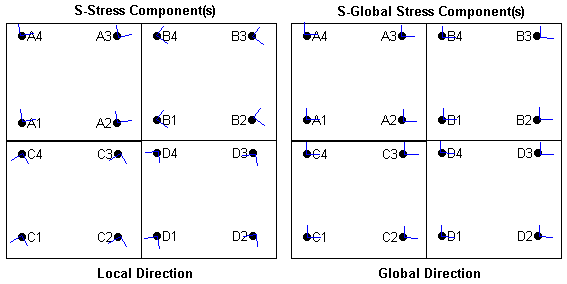Tensor Results |

|

|

|

|
|
Tensor Results |

|

|

|

|
In general, HyperView supports tensor results in global, analysis, and elemental (Nastran-like) systems. The analysis system means that the orientation or transform system is defined as model data in the Abaqus analysis. By default in Abaqus, all shell and membrane element results are in local in-plane systems. In addition, the material orientation for elements would change in a large deformation analysis. Therefore, the Abaqus ODB file does not contain any information about the *ORIENTATION or *TRANSFORM systems defined in the model. Instead, for every result in a local system, it contains the direction cosines of the corresponding system.

Every tensor result in the ODB file can be in local material systems that can change with time. As a result, HyperView creates two data types from each tensor result:
| • | scalar group with local results that are directly read from the ODB file |
| • | tensor group with global results that are transformed from the local results. |
These global data type names are prefixed with "-Global-". For example, there are two data types for element stresses: S-Stress components (s) and S-Global-Stress components (t). The local scalar group will get all components and valid invariants directly from the ODB file. The global tensor will have transformed global components and a set of invariants calculated by HyperView. The components and principal axes for a tensor data type can be viewed from the Tensor Plot panel.
HyperView system options include Global, Analysis, Elemental, and User-defined:
Global |
Nodal DOF directions or element material directions are in the global coordinate system. |
Analysis |
The analysis system is the associated local DOF directions (for nodes) or local material directions (for elements) defined in the model. It is equivalent to the Abaqus *TRANSFORM or *ORIENTATION systems. However in large deformation analysis, these systems can rotate with time in Abaqus. Because of this, the ODB file does not consider these systems as model information. Instead, nodal results are always in the global system and element results come with the direction cosines of the corresponding systems at each increment. As a result, analysis systems HyperView are not populated from the ODB file. in addition, the analysis system option is not relevant for Abaqus results. |
Elemental |
The elemental system is the default local system defined on the surface of planar elements (shell, membrane, etc). Abaqus uses the projection of the global axes onto the elements’ surface to define these in-plane systems. In large deformation analysis, these default local systems can rotate with time. As a result, the Elemental system option in HyperView does not represent the Abaqus elemental system. Rather, it is similar to the Nastran elemental system. |
User-defined |
Transforms vector results to a user-defined system. This option is available when *SYSTEM, *TRANSFORM, or *ORIENTATION systems are read into HyperView from an INP file. |